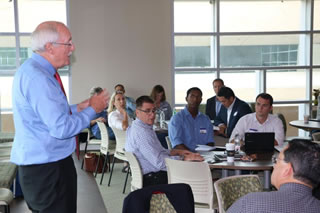News Archive
Breaking New Ground: Joint Special Operations University Taps Muma College of Business Educators in First-of-a-Kind Workshop
By Keith Morelli

TAMPA (August 1, 2018) -- Over the course of human history, situations that have arisen around the world that called for military intervention always were handled, more or less, in one simple way: Identify the adversary and eliminate the adversary.
But now, forward-thinking minds are forging a path toward a new way of doing things that may reshape our habits of physically attacking disagreeable neighbors.
Those winds of change picked up some momentum this week at a seminar about design science – the processes by which problems of all kinds are examined and solved. The workshop took place in the Muma College of Business and was cosponsored by the Joint Special Operations University at MacDill Air Force Base.
Discussed were far-reaching changes that could shift global confrontations from armed responses to peaceful negotiations.
And now, many are thinking there is a better way to examine problems and solutions, a way that has the potential to one day put an end to sending soldiers, particularly U.S. soldiers, in harm's way.
About 40 students – all professionals affiliated with the U.S. Special Operations Command and U.S. Central Command at MacDill Air Force Base – came to learn about design-science research, a field in which some Muma College of Business researchers have established themselves as leading experts.
Al Hevner, a professor in the Information Systems and Decision Sciences Department and one of the foremost authorities on design-science research, was the keynote speaker. He explained that when problems arise, there is a science to solving them. It goes beyond emotional actions and responses. Rather, it delves into matching certain problems with the right solutions. And getting to that point is a process that not only solves a particular problem but "contributes to human knowledge and can be extended to other fields."
Applying design science to the military's involvement overseas "is potentially huge," he said.
Victor Kelly, a retired U.S. Army colonel, said the future of interactions between nations lie in this problem-solving model.
"This may be what the Department of Defense looks like 10 years from now," he told the attendees. "That is why you're here, to help us get it right."
David Ellis, resident senior fellow with Joint Special Operations University, said the design-science field is emerging and needs to be fully understood to be successful. In the end, it could result in ways to avert open warfare.
In the workshop were U.S. Special Forces' personnel, civil-affairs workers, planners and U.S. Agency for International Development executives along with representatives from the Department of State. There were a couple of West Point cadets also.
The class split up into three groups over the three-day course to consider problems in Burkina Faso, a West African nation that has been wracked by civil unrest for the past 30 years.
Among the presenters at the seminar: Dan Lane, who has spent the past nine years working at SOCOM. He said design science is changing the way future military and diplomatic leaders will approach problems overseas and provide ways other countries may solve their own issues. There are a lot of military minds, trained in military tactics, that will be difficult to persuade, he said.
Whenever there is a situation, he said, the military traditionally does what it is trained to do.
"When we perceive an adversary, the first thing we think of is, 'Who do we need to kill and what do we need to destroy?'" Lane said. "And that's wrong."
He said that tactic fails to address the complexities of the ever-present big picture, like the will, strength and goals of the adversary. Who are others in the area and who will work to reach a solution? And what new and unforeseen problems arise from a perceived fix?
Answering these questions to shape a workable solution may one day replace deployment of troops, he said.
"We shouldn't reach for the hammer," he said, "but rather, the clay molding wheel."
The collaborative workshop is the latest example of innovation and engagement offered through the Muma College of Business. Already the college has an externship program through which professors are placed into real corporate offices for a semester, uses case studies to help the outside business community solve business problems and has developed the Center for Analytics and Creativity to lead the way in making the local region – and beyond – thrive.
And now, the JSOU/Muma College of Business collaboration.
Matt Mullarkey, the program director of the Muma College of Business DBA program and coordinator of the workshop, said this collaboration is a perfect fit of the goals of the MacDill institution and the research he, Hevner and others are conducting at USF.
"Our research effort with JSOU is a natural extension of the relationships we've been building with our DBA participants who connect us with the SOCOM and CentCom communities," Mullarkey said. "It also takes advantage of recent research Al and I have published on the elaborated action design-science research cycles that can be used to build and evaluate innovative systems."